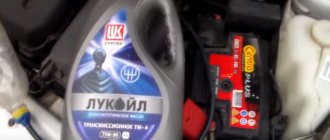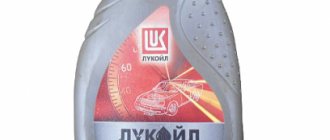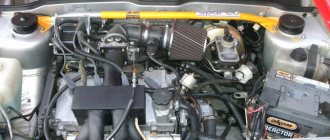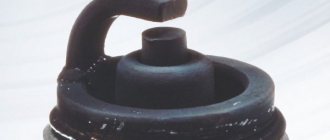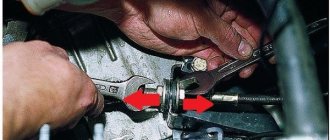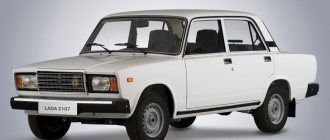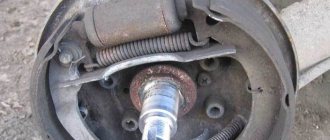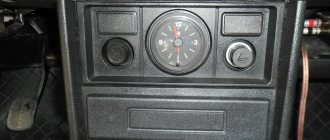Changing the engine oil is a standard procedure for all cars without exception. As a rule, it is done every 10 thousand km or once a year if the mileage per year is less than 10 thousand.
What kind of oil should be poured into the engine of a classic VAZ?
This does not mean the brand and viscosity, but the type: synthetic, semi-synthetic or mineral water. The engines of the Zhiguli classics, starting with a penny, were made and operated at a time when synthetic and semi-synthetic oil, if available, was as expensive as an airplane wing. Engine operating conditions are such that you can safely use mineral oil. If you have the money, you can use semi-synthetic, although you need to look under the car more often (in general, you should look under the car and inspect the engine at least after every 500 km). It’s definitely not worth pouring synthetics into VAZ engines - the quality of rubber parts is usually low. When using semi-synthetics, on a completely new Ukrainian-assembled seven, the front crankshaft oil seal became snotty - I had to change it.
To change the oil in a VAZ engine you need a minimum of tools:
- Hexagon 12 for drain plug
- oil filter puller
- waste oil container
If you don't have an oil filter puller, a classic long screwdriver will do.
Oil change procedure
Change the oil on a hot engine; if the engine is cold, start it and warm it up to operating temperature. If we plan to fill in oil of a different brand, then the engine should be flushed with special flushing oil, i.e. You will have to change the oil twice - first drain the old one and fill in the flushing oil without replacing the oil filter. Start the engine and let it run for 10-15 minutes, then drain the flushing oil and refill with fresh oil and change the oil filter, as described below.
- Turn off the engine
- Unscrew the filler cap on the engine
- We place a waste container under the drain hole
- Carefully, so as not to burn yourself with hot oil, unscrew the drain plug
- After the oil has drained, you can immediately tighten the drain hole, but I leave it open and do not remove the waste container, because when removing the oil filter, a little oil still leaks out.
- Using a puller, unscrew the oil filter. If there is no puller, take a long screwdriver and pierce the filter with a screwdriver as far as possible from the thread, and use a screwdriver to unscrew the old filter.
- Clean the filter seat from dirt with a rag
- Now we go down and tighten the drain plug
- Fill the new oil filter with about a third or half of the oil and lubricate the rubber filter seal with oil.
- Screw the filter until it stops by hand; there is no need to tighten the filter further.
- Add fresh oil
- Tighten the filler cap.
Don’t forget to remove the waste container from under the car!
The 1.5 triple engine is filled with 3.5-3.7 liters. It’s better not to fill everything first, but to fill 3-3.5 liters and check the dipstick after a couple of minutes - take it out, wipe it dry, put it back in place, pull it out again and only now check the level. You need to look at the light, because fresh oil is not dark and the level is not immediately visible. It is not necessary to fill to the MAX mark on the dipstick, it is better to fill so that the level is halfway between the minimum and maximum marks, drive for a couple of days, then you can top up if necessary. I usually take a 4-liter canister and change the oil and leave it for topping up.
WHY SHOULD YOU CHANGE THE OIL IN A VAZ 2107 ENGINE
The VAZ 2107 engine is literally stuffed with various rubbing parts, the surfaces of which require constant lubrication. If for some reason the oil does not reach the rubbing parts, they will immediately begin to overheat and eventually break. And first of all, the valves and pistons of the VAZ 2107 suffer from the lack of oil.
After such a breakdown, you cannot do without a major engine overhaul.
It is extremely rare to restore these parts after problems in the lubrication system. In the vast majority of cases, the engine requires a very expensive overhaul. That is why the driver must regularly check the level and quality of lubricant in the engine, and, if necessary, change it. In the VAZ 2107 operating instructions, the manufacturer recommends changing the oil every 15 thousand kilometers. However, experienced owners of “sevens” recommend changing the lubricant more often, every 8 thousand kilometers. Only in this case will the VAZ 2107 engine operate for a long time and stably.
Determining the oil change period
The presence of an oil pressure sensor on the power unit of the car greatly simplifies the determination of the right moment, upon the occurrence of which a planned replacement of the lubricant in the VAZ-2107 is necessary. For a more accurate timing, you need to pay attention to the oil pressure in different engine operating ranges. Basically, when the lubricant disintegrates (decomposes), the VAZ-2107 oil pressure indicator (installed on cars produced before 1988) indicates excess pressure in the system during startup and prolonged operation.
This occurs due to the liquefaction and boiling of the oil in the engine crankcase. If the vehicle does not have an oil pressure gauge, you should refer to the car manufacturer's instructions. The AvtoVAZ technical department recommends replacing the lubricant in the power unit every 6,000 kilometers when driving short distances and after 10,000 kilometers when driving regularly over long distances.
VAZ 2107 ENGINE WASHING AND OIL CHANGE
As mentioned above, completely draining the lubricant from a VAZ 2107 engine is a long process. The problem is that even after 20 minutes of draining, there is still waste left in the engine. This point is especially relevant if the oil is very old and therefore very viscous.
It will not be possible to remove thickened oil with a regular drain - you need to rinse with diesel fuel
Such oil simply does not pour out of the small channels and openings of the engine. To remove this viscous mass, the car owner will have to rinse the VAZ 2107 engine with diesel fuel.
WASHING SEQUENCE
An important point: after the liquid oil has completely drained from the VAZ 2107 engine, you must remove the old oil filter from the car and replace it with a new one. You can save on the quality of this filter, since it will be used only once, during washing.
- The drain hole, previously opened, is closed again with a plug. Diesel fuel is poured into the engine through the oil neck. Volume - 4.5 liters. Then a plug is installed on the neck, and the engine is cranked with a starter for 15 seconds. It is impossible to start the engine completely. To increase the efficiency of washing, the rear right wheel of the car can be raised by 15–20 cm using a jack.
- The drain plug on the crankcase cover is unscrewed again with a 12 mm socket wrench, and the diesel fuel along with the dirt is drained.
- After the diesel fuel is completely drained (which may take 10–15 minutes), the plug on the crankcase is screwed on, and 5 liters of fresh oil are poured into the engine through the oil neck, after which the plug on the neck is screwed on.
VIDEO: THE BETTER THING TO WASH THE MOTOR
How to remove the speed sensor VAZ 2107
To remove the speed sensor, you must perform the following operations:
- install the car above the inspection hole;
- engage the parking brake;
- place wheel chocks under the wheels;
- from the inspection hole, using a slotted screwdriver, unscrew the nut of the speedometer drive cable;
- disconnect the cable from the gearbox;
- loosen the plastic clamp that tightens the wiring harness coming from the speed sensor;
- press the spring clips and disconnect the block from the speed sensor;
- Using a 22mm wrench, unscrew the sensor from the speedometer drive;
- remove the speed sensor.
The VAZ 2107 speed sensor can be checked using a multimeter or “control”. To install the sensor, you must do the above steps in reverse order.
WHAT OIL CAN BE FILLED INTO THE VAZ 2107 ENGINE
A car owner who decides to change the oil on his “Seven” for the first time will inevitably face the question: which lubricant to choose? This is not an idle question, because there is a huge amount of motor oils on the modern market. It doesn’t take long to get confused by such abundance. Therefore, it is worth understanding the types of motor oils and their differences.
TYPES OF OILS
Essentially, engine oils are divided into three types:
- synthetic oil;
- semi-synthetic oil;
- mineral oil.
Now let's look at each type of oil in more detail:
- Synthetic motor oils are the most expensive. This should not be surprising: “synthetics” have excellent temperature parameters and viscosity. If the driver has filled in with high-quality synthetic oil, he can be sure that it will not freeze even at -50°C, and this circumstance is very useful given our climate;
- Semi-synthetic motor oils are a mixture of mineral and synthetic oils. “Semi-synthetics” do not have such a wide range of operating temperatures, but they have one undoubted advantage: they are cheaper;
- Mineral motor oils are the cheapest today. The reason is simple: the viscosity of these oils directly depends on the outside temperature. For example, at forty-degree frost, most mineral oils turn into a substance similar to plasticine.
Refill tanks for VAZ 21074 injector
After purchasing a car, many novice car owners ask a number of questions regarding fuels, lubricants and operating fluids.
Even “experienced” drivers are not always confident in the correct maintenance of their car, and therefore turn to various books and other sources for the necessary information. Some people ask car dealers for advice, and they, in turn, use special manuals and applications for a particular make and model of car to answer their questions.
The table below contains basic information on the lubricants, operating fluids and fuel (gasoline) used, and also provides data on the locations and volumes of refueling for VAZ 2101, 2102, 2103, 2104, 2105, 2106, 2107 or simply “ classic ” cars.
Here you can find answers to the following questions:
- What is the car's gas tank capacity?
- What kind of gasoline should I use?
- What kind of engine oil should I pour into the engine, oil volume?
- What kind of transmission oil should I pour into the box, rear axle? What is the volume of the crankcases?
- The difference in the volume of a 4 and 5 speed gearbox?
- What is the volume of the brake system? Clutches?
- What brake fluid should I add?
- What fluid or oil should I pour into the front and rear shock absorbers?
- What is the filling volume of the cooling system? What coolant should I use?
- Recommended windshield washer fluid? Washer reservoir volume?
- What lubricant should I use for bearings, ball joints, steering rods?
- How to lubricate hinges, door locks, battery terminals?
This is a reminder for drivers of the VAZ 2107 (also relevant for other classics), I decided to create it because minor technical questions often arise, and it takes a lot of time to find the answer. And here everything is in one place. Save this reminder in your bookmarks or on your page on a social network, and use the social network buttons under the article for your health.
CHOICE OF OIL FOR VAZ 2107
Taking into account everything said above, it becomes clear: the choice of lubricant for the VAZ 2107 engine primarily depends on the climatic conditions in which the car is operated. If a car owner operates a car in a region with a positive average annual temperature, then he should use a simple and cheap mineral oil, such as LUKOIL TM-5.
Conventional mineral oil LUKOIL TM-5. Works well in warm climates
If the car owner lives in a region with a temperate climate (which predominates in central Russia), then it would be more advisable to fill in semi-synthetic oil. For example, Mannol Classic 10W40.
Semi-synthetic oil Mannol Classic 10W40 is the optimal choice for the regions of central Russia
And finally, residents of the Far North and regions close to it will have to use exclusively high-quality synthetic oils. A good option is MOBIL Super 3000.
MOBIL Super 3000 oil performs excellent in extreme temperatures, but comes at a steep price
HOW THE OIL FILTER IS DESIGNED FOR VAZ 2107
When changing the oil on a VAZ 2107, car owners usually also replace the oil filter. Let's try to figure out what kind of device this is and what it comes in. Oil filters are divided into three types:
- filters with modular housing;
- filters with a collapsible housing;
- filters with a non-separable housing.
The most expensive are collapsible filters. But at the same time they also have the longest service life. When a filter of this type becomes clogged, the car owner removes it, opens the housing, removes the filter element and replaces it with a new one.
Filters with non-removable housings do not last long because they are disposable devices. As soon as the filter elements in such a filter become dirty, the car owner simply throws it away.
A filter with a modular housing is a hybrid of a collapsible and non-separable filter. The modular housing is only partially disassembled, so the car owner only has access to the filter element. The remaining filter parts remain inaccessible.
The filter housing can be anything you want, but the “filling” of this device is almost always the same.
The filter housing may be different, but its “filling” is always the same
The body always has the shape of a cylinder. There are two valves inside: forward and reverse. There is also a filter element inside connected to a spring. On the outside of each filter there is a small rubber O-ring. It prevents oil leakage.
The filter element is made of filter paper with special impregnation. This paper is folded many times, so that a kind of “accordion” is formed.
A paper “accordion” allows you to increase the filter surface area by 28 times
This technical solution is necessary to ensure that the filter surface area is as large as possible. The direct valve allows oil to enter the engine when the main filter element is clogged. In fact, the straight valve is an emergency device. It lubricates the rubbing parts of the engine with unrefined oil. And when the car engine stops, the check valve comes into play. It traps oil in the filter and prevents it from flowing back into the crankcase.
Thus, the choice of oil filter for the VAZ 2107 depends entirely on the car owner’s wallet. Anyone who wants to save money chooses a non-separable filter. Those who are not constrained by funds install collapsible or modular devices. A good option here is a filter from MANN.
MANN is perhaps the most popular collapsible oil filter among VAZ 2107 owners
Modular devices from CHAMPION are also in constant high demand among owners of “Sevens”.
The CHAMPION filter is cheaper than MANN, but has a modular design
Well, if money is short, then you can take a closer look at the Nf-1001 disposable filters. As they say, cheap and cheerful.
Disposable filter Nf-1001 will help out the driver who is tight on money
ABOUT THE FREQUENCY OF REPLACING OIL FILTERS
If you look at the VAZ 2107 operating instructions, it says that oil filters should be changed every 8 thousand kilometers. The problem is that mileage is far from the only criterion by which the wear and tear of a device is determined. You can tell if the filter is worn out by checking the engine oil. If a car owner, checking the oil with a dipstick, sees dirt on the dipstick, it means the filter is not working well and needs to be replaced. The life of the filter is also affected by the driving style of the car. If the car is driven too aggressively, the oil filters become clogged faster. Finally, the operating conditions of the car. If the car owner has to constantly drive in heavy dust, then the oil filters will have to be changed very often.
REPLACING ANTI-FREEZE SENSOR ON A VAZ 2107
First of all, it should be said that the temperature sensors on the VAZ 2107 cannot be repaired. The reason is simple: this device does not contain parts and materials that the driver could purchase and replace himself. In addition, the body of the temperature sensor is not dismountable, so it is simply impossible to get to the insides of this device without breaking it. Here's what you need to replace it:
- new temperature sensor VAZ 2107;
- 30mm socket with a long wrench (or a regular spark plug wrench);
- container for draining coolant.
SEQUENCE OF OPERATIONS
- The car is placed on a viewing hole or on an overpass. Place a container under the drain hole, unscrew the plug, and drain the antifreeze.
- The contact wires are removed from the sensor. They must be carefully pulled towards you.
- The sensor is unscrewed with a socket by 30 (remember that under the sensor there is a very thin o-ring that can be easily lost).
- A new one is screwed in place of the unscrewed sensor (and when screwing in a new sensor, you should not use too much force, especially if the driver of the socket head is very long: the thread in the sensor socket is easily torn off).
- The cap with the contact wires is put back on the sensor, and new antifreeze is poured into the expansion tank.
Replacement Regulations
The manufacturer advises changing the engine oil in the VAZ-2107 engine every 10 thousand kilometers. But this is a conditional indicator that can be reduced or increased depending on the condition of the oil. For example, if it darkens and stinks ahead of schedule, then an oil change will be required at the 6th or 7th thousand. Since the VAZ-2107 is an unpredictable car, the rule is that it is better to change the oil in advance. If you are late with an oil change, you may face irreversible consequences. It may come down to a major overhaul of the engine. But on the other hand, the oil can last for 15 thousand kilometers if the car is operated in favorable climatic zones - for example, on good roads, in warm weather, and without frost.
Replacement of gas tank and major repairs
Regardless of what type of fuel injection is used on your vehicle, the process for removing the tank will be the same. First drain all fuel from it. Next, carry out the following work:
- Remove the plastic casing from the container. To do this, you will need to unscrew several screws using a Phillips screwdriver.
- Disconnect the wires from the contacts leading to the fuel sensor.
- Use pliers to pry off the fuel hose.
- Unscrew the bolt of the tension plate that secures the gas tank.
- Remove the cap from the neck and carefully remove the tank.
Assess its condition. If there are several leaks or they are too large, then it will be easier to replace the entire fuel container. To do this, simply take a new tank and reassemble it in the reverse order.
If you do not have the opportunity to buy a new container, then stock up on:
- fiberglass;
- epoxy resin;
- acetone;
- sanding paper.
Which oil to choose
Before you know the oil volume, you should pay attention to the most important oil parameters. We are talking about viscosity characteristics, as well as the API quality grade, which is designated as the letters SH, SH, SJ and SL. As for viscosity, here we need to take into account the set of numbers before and after the letter W. For example, the first number (before the W) indicates the cold start temperature, and the second indicates the viscosity. If the car is new, the viscosity should be at the level of -30, and with 100 thousand mileage - 50. If the mileage is even higher, then a viscosity with a figure of 60 or more is suitable.
As for choosing a brand, it all depends on brand preferences. But it is advisable to choose among well-known companies. Among the most trusted companies, we note Shell, Lukoil, Mobile, Castrol, Texaco and Motul.
Getting ready for replacement
Before you start replacing, you need to learn a few simple rules. Changing the fluid should be carried out on a warm engine, when the fluid has better fluidity. If the engine is cold, start it and wait until it warms up to operating temperature. If you are thinking of changing the brand of oil, then you should wash the engine with a special cleaning compound.
The replacement will have to be carried out twice - first drain the waste, and then pour in the flushing fluid (fill the entire volume) or flushing lubricant - but the oil filter should not be replaced. We start the engine for ten to fifteen minutes, then turn it off and drain the flushing oil. We proceed to the procedure of filling with fresh oil, and the oil filter must be changed.
What kind of oil should I use?
What kind of oil to pour is up to each motorist to decide individually. But for all cars the assignments are practically the same.
In terms of viscosity, the first number before the letter W shows the cold start temperature, the last number indicates the viscosity itself. For the central regions of our country, if the car is new, it’s 30; if it’s used, that is, it has traveled more than 100 thousand, then it’s 40; if it’s old and the mileage is more than 200 thousand, then 50, and if the mileage is even higher, then 60 .
Quality according to API: SG, SH, SJ, SL, checked with the recommendations of the car manufacturer as indicated on the packaging.
By brand there is a choice according to the means. The better, the more expensive. Shell, Mobil, Castrol, Texaco, Motul and several other popular brands, but their prices are very high.
The best oil is synthetic, followed by semi-synthetic and lastly mineral.
The viscosity of the motor lubricant must be selected depending on temperature fluctuations in the area in which the vehicle is operated.
| Classification | Temperature of use |
| 10W30 | -25 °С to +25 °С |
| 10W40 | -20 °С to +35 °С |
| 5W40 | -30 °С to +35 °С |
| 0W40 | -35 °С to +30 °С |
Engine oil volume
Many novice motorists may not be aware of how much oil is needed. To change the lubricating mixture in a VAZ-2107 engine, you will need about four liters of new lubricant, because it is almost completely consumed. At some service stations, mechanics fill the canister completely.
Types of oil
- Synthetic is the thinnest oil. Due to its fluidity, such a liquid is very resistant to low temperatures and never freezes in cold weather. Recommended for new cars, including VAZ-2107 with low mileage.
- Mineral oil is the cheapest and thickest oil. Perhaps these are all its advantages. Not suitable for low temperatures, but it will be the best option for cars with high mileage.
- Semi-synthetic is a cheaper oil than pure synthetics. But at the same time, its advantages pale in comparison to real synthetic oil. And yet, semi-synthetic is definitely better than mineral oil. Considering the fact that the car is cheap, this oil is suitable for it.
How to change engine oil on a VAZ Seven?
When faced with the question of what oil to pour into the engine, you must be guided by the technical documentation developed by the manufacturer of a particular car. The fluid replacement procedure is considered quite simple. However, there are a number of nuances that should be taken into account when filling in new lubricant.
The VAZ 2107 oil change, according to the factory specifications, should be done every 6-15 thousand kilometers. At the same time, it is not always clear how much fluid needs to be poured into the engine. In addition, the regularity of oil changes for VAZ directly depends on the operating conditions of the vehicle and on how much lubricant is used.
How much to fill
The volume of fluid poured is very important during the oil change process, because underfilling or overfilling can negatively affect engine reliability. So, for the VAZ-2107, about 4 liters of new semi-synthetic oil are recommended. This is how much oil should be included during a complete change, that is, with a comprehensive flush. If a partial replacement is made, you will have to fill in a little less oil, since the old fluid will still remain in the engine.
Sources
- maslospec.ru/skolko-masla-v-dvigatele-vaz-2107.html
- bumper.guru/klassicheskie-modeli-vaz/dvigatel/zamena-masla-v-dvigatele-vaz-2107.html
- rmark.ru/302/lada/2107/
- drive2.ru/l/288230376153061080/
- ladaautos.ru/vaz-2107/vaz-2107-skolko-masla-zalivat.html
Filling volumes and brands of oils and liquids LADA (VAZ-2107 Zhiguli)
| Filling/lubrication point | Filling volume, liters | Name of oil/liquid |
| Fuel tank | 39 (42) | Motor gasoline with octane number 92 - 95 |
| Engine cooling system including interior heating system | 8,65 | Coolant with a freezing point not higher than -40 C |
| Engine lubrication system, including oil filter, at ambient temperature: from -20 to +45 °С from -25 to +35 °С from -25 to +25 °С from -30 to +35 °C from -30 to +25 °C from -35 to +30 °C | 3,75 | Motor oils (with API quality level: SG, SH, SJ) SAE 15W-40 SAE 10W-40 SAE 10W-30 SAE 5W-40 SAE 5W-30 SAE 0W-40 |
| Gearbox housing | 1,6 | Gear oils with quality level according to API GL-4 or universal GL4/GL5 and viscosity 75W-90, 80W-90 |
| Rear axle housing | 1,3 | Gear oils with quality level according to API GL-5 and viscosity 75W90, 80W-90 |
| Steering gear housing | 0,215 | Gear oil 75W-90 |
| Hydraulic brake system | 0,382 | DOT-4 brake fluid |
| Hydraulic clutch release system | 0,18 | DOT-4 brake fluid |
| Windshield and tailgate washer reservoirs | 2.0 or 5.0 | A mixture of water with a special liquid REVIEW, GLASSOL or windshield washer fluid ASPECT |
| Starter drive drive ring | — | Lubricant Litol-24, AGIP GREASE 30, ESSO UNIREX No. 2 |
| Front wheel bearings | — | Litol-24 lubricant |
| Cardan joint cross bearings | — | Lubricant FIOL-2U, No. 158 |
| Front propeller shaft spline | — | Lubricant FIOL-1, CV joints-4 |
| Door limiters | — | CV joint grease-4 |
| Seat moving slides | — | Lubricant FIOL-1 |
| Tie rod joints and front suspension ball joints | — | ShRB-4 grease |
| Battery leads and terminals, trunk lid torsion bars, door and trunk lid keyholes | — | Automatic lubricant VTV-1 in aerosol packaging, CIATIM-201, -221, Litol-24 |
| Door, hood, trunk lid locks | — | Lubricant FIOL-1 |
| Pressure regulator | — | Grease DT-1 |
How much and what to fill in VAZ 2107
Fuel system
Fuel tank volume – 39 l. The manufacturer recommended using gasoline with an octane rating of 92 or 95.
Engine lubrication system
The quality of operation of components and assemblies depends on the regularity of replacing lubricants. Engine oil lasts no more than 10 thousand km. After which it is necessary to change it to a new one. Lubricant fluid (with API quality level: SG, SH, SJ) is suitable for the VAZ 2107. During the procedure, a new oil filter must be installed. The same oil is used for the engine crankcase as for the power plant.
Engine cooling system
The service life of antifreeze is 60 thousand km. Even if the car is not used, the fluid loses its properties after two years, so it needs to be replaced.
Transmission
The transmission oil is changed every 60 thousand km. At the same time, its level is periodically monitored. After 20 thousand km it may decrease, which will negatively affect the operation of the unit. The defect must be eliminated and oil must be added to the edge of the filler hole. This also applies to the rear axle housing. The gearbox filling volume is 1.6 liters.
Brake system
Brake fluid should be replaced once every two years regardless of the vehicle's mileage. Domestic DOT-4 or a foreign equivalent is recommended.
Home/Car brands/Lada/2107 1st generation
